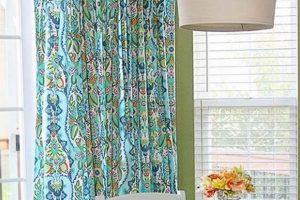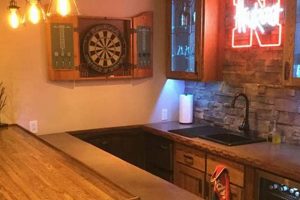The subject under consideration pertains to concepts and designs for constructing seating structures independently, without professional assistance. Examples include repurposing reclaimed lumber into a rustic outdoor seat, fashioning a minimalist indoor bench from concrete blocks and a finished wood plank, or creating a storage solution using an old dresser transformed into a functional entryway seat.
Self-directed creation of these furnishings fosters resourcefulness, personal expression, and cost savings. Historically, the ability to craft functional items domestically was vital for self-sufficiency. Contemporary engagement with these projects reflects a desire for customization, sustainability, and a tangible connection to the creation process.
The following discussion will delve into diverse material selections, structural considerations, and aesthetic approaches relevant to successful self-directed bench construction.
Essential Guidance for Self-Constructed Seating
The subsequent guidelines offer fundamental advice for individuals undertaking independent seating construction, encompassing material selection, structural integrity, and finishing techniques.
Tip 1: Material Selection: Prioritize durable materials suited to the intended environment. For outdoor applications, pressure-treated lumber or naturally weather-resistant woods like cedar or redwood are recommended to resist rot and insect damage. Indoor benches can utilize a wider variety of wood species, including hardwoods for increased durability or softwoods for ease of workability.
Tip 2: Structural Planning: Develop a detailed plan or sketch outlining dimensions, joint types, and load-bearing considerations. Ensure the design adequately distributes weight to prevent structural failure. Triangles and bracing are crucial for adding stability and preventing racking.
Tip 3: Joint Construction: Choose appropriate joinery techniques based on skill level and desired aesthetic. Basic butt joints, reinforced with screws or nails, are suitable for simpler designs. More advanced joinery methods, such as mortise-and-tenon or dovetail joints, offer superior strength and visual appeal.
Tip 4: Surface Preparation: Thoroughly sand all surfaces to remove imperfections and create a smooth, consistent finish. Start with coarse-grit sandpaper and progressively move to finer grits. Proper sanding ensures optimal adhesion for paints, stains, and sealants.
Tip 5: Finishing Application: Select a finish that provides protection and enhances the natural beauty of the material. Exterior benches require finishes with UV inhibitors and water resistance. Interior benches can benefit from stains to highlight the wood grain or paints to add color. Apply multiple coats of finish, allowing adequate drying time between each coat.
Tip 6: Hardware Selection: Utilize corrosion-resistant hardware, such as stainless steel or galvanized fasteners, particularly for outdoor applications. Choose appropriately sized screws and bolts to ensure secure connections without splitting the wood. Consider using washers to distribute pressure and prevent pull-through.
Tip 7: Weight Distribution: Carefully consider the placement of legs or supports to evenly distribute weight across the entire structure. Avoid placing supports too close together, as this can create weak points. Wider benches may require additional center supports to prevent sagging.
Adherence to these guidelines will contribute to the creation of durable, aesthetically pleasing, and structurally sound seating.
The subsequent sections will elaborate on specific design styles and project examples to further inspire and inform your independent seating endeavors.
1. Material Selection
Material selection constitutes a foundational element in self-directed seating projects. The choice of materials directly impacts the bench’s durability, aesthetics, cost, and suitability for its intended environment. Careful consideration of these factors is therefore paramount.
- Wood Species
The selection of wood species influences both the visual appeal and structural properties of the bench. Hardwoods, such as oak or maple, offer superior durability and resistance to wear, making them suitable for high-traffic areas. Softwoods, like pine or cedar, are generally more affordable and easier to work with, though they may require additional protection against moisture and impact. The grain pattern and color of the wood also contribute to the overall aesthetic.
- Reclaimed Materials
Utilizing reclaimed wood or other repurposed materials offers a sustainable and cost-effective alternative to purchasing new lumber. Reclaimed materials can introduce unique character and historical context to the bench’s design. However, reclaimed materials may require careful preparation, including cleaning, sanding, and the removal of old fasteners, to ensure structural integrity and safety.
- Metal Components
Metal components, such as steel or aluminum, can be incorporated into seating designs to provide structural support, create visual contrast, or add industrial aesthetic elements. Metal legs, frames, or decorative accents can enhance the bench’s stability and durability. The selection of appropriate metal finishes, such as powder coating or galvanization, is crucial for preventing corrosion, particularly in outdoor applications.
- Fasteners and Adhesives
The selection of appropriate fasteners and adhesives is critical for ensuring the long-term structural integrity of the bench. Screws, bolts, and nails must be properly sized and compatible with the chosen materials to provide secure connections. Exterior-grade adhesives should be used to bond components that will be exposed to moisture or extreme temperatures. The use of high-quality fasteners and adhesives contributes to the overall durability and longevity of the seating structure.
The preceding facets highlight the diverse considerations involved in material selection for independent seating projects. The informed selection of materials, guided by factors such as durability, aesthetics, and environmental suitability, is essential for achieving a successful and enduring outcome. Ignoring these considerations can significantly compromise the project’s overall quality and longevity.
2. Structural Integrity
Structural integrity represents a critical determinant of safety and longevity in independently constructed seating. A failure to adequately address structural considerations during the planning and execution phases of seating creation can result in hazardous conditions, including collapse or instability under load. The connection between this and independent seating concepts centers on the responsibility of the constructor to ensure the design
and implementation adhere to sound engineering principles.
Real-world examples underscore the significance of this understanding. An improperly supported bench constructed from reclaimed lumber may exhibit unacceptable deflection or even catastrophic failure if the load-bearing capacity of the materials is exceeded. A bench utilizing inadequate joinery techniques, such as simple butt joints without reinforcement, may gradually weaken over time due to repeated stress, leading to instability. Therefore, an understanding of load distribution, material properties, and appropriate joinery methods is essential. A bench with a cantilever design, where a portion extends beyond the supports, requires calculations to ensure the supports can handle the torque.
In summary, structural integrity is non-negotiable in independently created seating. Neglecting these principles compromises safety and diminishes the lifespan of the creation. A focus on sound design, proper material selection, and skillful execution of construction techniques ensures safe, durable, and aesthetically pleasing seating solutions. Over-engineering is sometimes preferable to under-engineering.
3. Joint Construction
The successful creation of seating independently necessitates careful consideration of joint construction. The method by which individual components are joined directly affects the structural integrity, stability, and overall aesthetic of the finished piece. Skillful joint construction elevates the quality and longevity of seating solutions, while inadequate joinery compromises the outcome.
- Butt Joints
Butt joints represent the simplest form of joining two pieces, where the ends are directly connected. While straightforward to execute, butt joints possess inherently limited strength and require reinforcement through fasteners like screws or nails, or the addition of supplemental bracing. Within seating created independently, butt joints are suitable for non-critical connections where minimal stress is applied. For example, attaching a decorative trim piece to a bench seat might employ a butt joint, but load-bearing connections require stronger alternatives.
- Lap Joints
Lap joints involve overlapping two pieces of material, increasing the surface area for bonding and mechanical fastening. This overlap enhances the joint’s strength compared to a butt joint, providing greater resistance to tension and shear forces. An instance of lap joint application can be found in creating the frame for a simple outdoor bench, where the seat supports are lapped onto the legs for increased stability. The degree of overlap directly correlates to the joint’s strength, thus influencing the bench’s overall capacity.
- Mortise and Tenon Joints
Mortise and tenon joints consist of a projecting tenon that fits snugly into a corresponding mortise or hole. This type of joint offers superior strength and stability, particularly when reinforced with glue or a wedge. The application is frequently observed in constructing robust bench legs or framing elements where significant weight-bearing capacity is required. The precision with which the mortise and tenon are crafted directly impacts the joint’s performance and the bench’s overall structural integrity.
- Dovetail Joints
Dovetail joints are characterized by interlocking, wedge-shaped projections that provide exceptional resistance to pulling forces. This joint is renowned for its aesthetic appeal and is often used in high-quality furniture construction. In the context of seating, dovetail joints can be used to join the sides of a bench seat or to attach decorative elements, providing both structural support and visual enhancement. The complexity of creating dovetail joints requires skill and precision, but the resulting strength and aesthetic value often justify the effort.
The preceding facets underscore the importance of carefully selecting appropriate joint construction methods in seating projects. The choice depends on factors like the intended load, the materials used, and the desired aesthetic. Successfully implemented joint construction elevates seating from a simple structure to a durable and visually appealing piece of furniture. In contrast, inadequately considered joinery introduces inherent risks, potentially leading to premature failure and compromising the user’s safety.
4. Ergonomic Design
Ergonomic design principles are fundamentally relevant to independently constructed seating. While the allure of personalized design and cost savings drives many self-directed bench projects, prioritizing ergonomic considerations ensures the finished product promotes user comfort and minimizes the risk of musculoskeletal strain. Integrating ergonomic principles elevates the functional value and long-term usability of such projects.
- Seat Height
Seat height constitutes a primary ergonomic factor. An appropriate seat height allows users to sit with their feet flat on the floor and their knees bent at a 90-degree angle, minimizing pressure on the lower back and promoting proper circulation. Seat heights that are either too high or too low can induce discomfort and contribute to postural problems. The average adult requires a seat height between 16 and 20 inches, though adjustments may be necessary to accommodate variations in user height and intended use. For example, a bench intended for dining may require a higher seat height than one designed for casual seating.
- Seat Depth
Seat depth, or the distance from the front edge of the seat to the backrest, influences the amount of support provided to the thighs. An adequate seat depth allows users to sit comfortably without excessive pressure behind the knees. Conversely, a seat depth that is too short may leave the thighs unsupported, leading to discomfort and fatigue. The ideal seat depth typically ranges from 16 to 18 inches, but individuals with longer legs may require greater depth. Applying ergonomic design, seating created independently with shallow seat depths would be appropriate for temporary seating.
- Lumbar Support
Lumbar support addresses the natural curvature of the lower back. Integrating lumbar support into the design of a bench backrest helps maintain proper spinal alignment and reduces strain on the lower back muscles. This can be achieved through a curved backrest or the addition of a separate lumbar cushion. A lack of adequate lumbar support can contribute to back pain and discomfort, particularly during prolonged sitting. As such, seating created independently frequently ignores lumbar support. Seating designs focusing on ergonomic considerations should address this design element.
- Seat Angle
The angle of the seat, whether flat, slightly inclined forward, or slightly inclined backward, impacts the distribution of weight and the position of the pelvis. A slight forward tilt can encourage an upright posture and reduce pressure on the tailbone. A slight backward tilt may provide a more relaxed seating position but could potentially lead to slouching if not combined with adequate lumbar support. Experimentation with different seat angles can help determine the most comfortable and ergonomically sound configuration for a particular bench design.
These considerations are significant. While personalize
d aesthetics and resourceful construction are commendable aspects of self-directed bench projects, prioritizing ergonomic principles ensures the finished product is not only visually appealing but also conducive to user comfort and well-being. Neglecting these factors can result in seating that is aesthetically pleasing but ultimately impractical or even detrimental to health.
5. Aesthetic Consistency
Aesthetic consistency, in the context of independent seating construction, refers to the harmonious integration of design elements to create a unified and visually pleasing outcome. Achieving aesthetic consistency requires careful consideration of various design facets and their interrelationships to ensure a cohesive and intentional appearance.
- Material Palette
The selection of materials exerts a substantial influence on the overall aesthetic. Maintaining a consistent material palette, whether through the use of similar wood tones, complementary colors, or a deliberate contrast of textures, contributes to a sense of visual unity. For example, a bench constructed with a combination of reclaimed wood and raw steel can achieve aesthetic consistency through the deliberate repetition of these materials in other design elements within the space, such as shelving or lighting fixtures. In contrast, an indiscriminate mixing of disparate materials without a unifying element can result in a visually disjointed outcome.
- Form and Proportion
The form and proportion of the bench’s individual components, as well as the overall structure, play a crucial role in achieving aesthetic harmony. Consistent use of geometric shapes, whether rectilinear or curvilinear, contributes to a unified design. Likewise, adhering to consistent proportions, such as the ratio between the seat height and depth or the thickness of the legs and the seat, creates a sense of balance and visual appeal. A bench with excessively thick legs relative to the seat may appear visually unbalanced, while a bench with overly delicate legs may appear fragile or unstable.
- Color and Finish
The application of color and finish constitutes a powerful means of achieving aesthetic consistency. Selecting a consistent color scheme, whether monochromatic, analogous, or complementary, unifies the overall appearance of the bench and its surrounding environment. Similarly, applying a consistent finish, such as a clear coat, stain, or paint, ensures a uniform texture and sheen. A bench painted in a color that clashes with the surrounding decor may appear out of place, while a bench with an inconsistent finish may appear poorly executed.
- Style Integration
Integration into a specific design style, whether modern, rustic, or traditional, promotes visual coherence. Adhering to the defining characteristics of a chosen style, such as minimalist lines in modern design or distressed finishes in rustic design, ensures the bench seamlessly integrates with its intended environment. A modern bench with ornate carvings may appear incongruous, while a rustic bench with sleek, chrome legs may lack authenticity. Maintaining fidelity to a chosen style strengthens the overall aesthetic impact of the finished piece.
The convergence of these facets highlights the importance of aesthetic consistency in independently constructed seating. Thoughtful consideration of material palette, form and proportion, color and finish, and style integration promotes a unified and visually pleasing result, enhancing the functional and aesthetic value of the finished bench. Neglecting these considerations may result in a disjointed and visually unappealing outcome, undermining the overall success of the project.
6. Finish Durability
Finish durability is critically linked to the long-term viability and aesthetic appeal of seating created independently. The finish acts as a protective barrier, shielding the underlying material from environmental factors, wear and tear, and potential damage. Premature finish degradation necessitates costly and time-consuming repairs or replacement, directly undermining the initial cost savings and personalization benefits associated with self-directed bench construction. The proper selection and application of durable finishes are, therefore, integral to the success of these endeavors.
The causal relationship between finish quality and bench longevity is readily apparent. For exterior seating, exposure to ultraviolet radiation, moisture, and temperature fluctuations accelerates finish breakdown. Without a durable, weather-resistant finish, wooden benches are susceptible to rot, cracking, and discoloration, while metal components may corrode. Interior seating faces different challenges, including abrasion from regular use, staining from spills, and chemical damage from cleaning agents. A poorly chosen or inadequately applied finish offers insufficient protection against these factors, resulting in premature wear and diminished aesthetic appeal. For example, a clear polyurethane finish, when appropriately applied, would increase the durability. Ignoring this would result in surface damage with general use.
In conclusion, finish durability is not merely an aesthetic consideration but a fundamental component of the functional lifespan of seating constructed independently. Selecting appropriate finishes tailored to the intended environment and applying them meticulously ensures long-term protection, preserves aesthetic appeal, and ultimately maximizes the value of the self-directed project. Challenges may arise in identifying the optimal finish for a given application, requiring careful research and consideration of material compatibility, environmental factors, and intended use. Overcoming these challenges through informed decision-making contributes to the overall success and sustainability of independent seating construction.
7. Space Optimization
Effective space utilization constitutes a primary consideration within independent seating construction. Limited spatial resources often necessitate furniture designs that maximize functionality and minimize occupancy. The integration of space optimization principles is therefore integral to the successful execution of self-directed bench projects, particularly in constrained environments.
- Integrated Storage
Incorporating storage compartments directly within the bench structure represents a strategic approach to space optimization. Hinged seats, drawers, or open shelving beneath the seating surface provide concealed or accessible storage for items that would otherwise occupy valuable floor space. Examples include entryway benches with shoe storage, living room benches with blanket compartments, or bedroom benches with integrated drawers for clothing or linens. The dimensions and configuration of the storage areas should be tailored to the specific needs and available space within the environment.
- Foldable or Collapsible Designs
Foldable or collapsible bench designs offer a flexible solution for spaces where seating is only required intermittently. These benches can be easily folded and stored when not in use, fre
eing up valuable floor space for other activities. Examples include foldable picnic benches, collapsible entryway benches, or wall-mounted benches that can be folded down when needed. The construction of these benches requires careful attention to hinge mechanisms and locking systems to ensure stability and safety when in use. - Multi-Functional Designs
Creating seating with multiple functions represents a strategy for maximizing utility within a limited space. Benches can be designed to serve as both seating and a coffee table, a room divider, or even a temporary workstation. Examples include benches with a hinged top that can be flipped over to create a flat work surface, benches with built-in planters, or benches with adjustable height settings. The design of multi-functional benches requires a careful balance between the different functionalities to ensure usability and aesthetic appeal.
- Corner or Niche Optimization
Corners and niches often represent underutilized space within a room. Designing benches specifically to fit into these areas can effectively maximize seating capacity without encroaching on valuable floor space. Corner benches can be constructed to wrap around a corner, providing ample seating while utilizing otherwise wasted space. Niche benches can be built to fit snugly into alcoves or recesses, creating a cozy and functional seating area. Careful measurement and planning are essential to ensure a precise fit and optimal space utilization.
These considerations illustrate the diverse strategies available for optimizing space within independent seating projects. Integrating storage, incorporating foldable designs, creating multi-functional pieces, and utilizing corner or niche spaces are all viable approaches to maximizing utility and minimizing spatial impact. The successful implementation of these strategies requires careful planning, precise execution, and a clear understanding of the specific spatial constraints and functional requirements of the environment.
Frequently Asked Questions Regarding Independent Seating Construction
This section addresses common inquiries and clarifies essential considerations related to self-directed seating projects.
Question 1: What is the minimum set of tools required for constructing a basic wooden bench?
A minimal toolset includes a saw (hand saw or circular saw), a drill with various drill bits, a measuring tape, a level, a square, sandpaper, safety glasses, and a pencil for marking. Clamps are also highly recommended for holding pieces securely during assembly.
Question 2: How can one determine the appropriate dimensions for a bench based on its intended use?
Bench dimensions should be tailored to the intended users and function. Standard seat height ranges from 16 to 20 inches. Seat depth should be sufficient to comfortably support the thighs, typically between 16 and 18 inches. Length will vary based on the desired seating capacity. Consider consulting ergonomic guidelines for optimal comfort.
Question 3: What are the primary safety precautions to observe when working with power tools during seating construction?
Essential safety precautions include wearing appropriate eye and ear protection, using tools with sharp blades or bits, unplugging tools before changing blades or bits, securing workpieces with clamps to prevent movement, and working in a well-ventilated area. Familiarity with the tool’s operating manual is crucial.
Question 4: How should one prepare reclaimed wood for use in a seating project?
Reclaimed wood requires thorough inspection and preparation. Remove any nails, screws, or other fasteners. Clean the wood to remove dirt, grime, and loose paint. Sand the surfaces to smooth them and remove any splinters. Consider applying a sealant to protect the wood from moisture and pests.
Question 5: What types of wood finishes are most suitable for outdoor seating?
Outdoor seating requires finishes that provide protection against moisture, ultraviolet radiation, and temperature fluctuations. Exterior-grade paints, stains with UV inhibitors, and marine varnishes are suitable options. Apply multiple coats according to the manufacturer’s instructions.
Question 6: How can one ensure the stability of a bench with a long span between supports?
To enhance the stability of a long bench, increase the thickness of the seat material, add additional supports (legs or a center support), or incorporate bracing (triangular supports) between the legs and the seat. Proper joint construction is also critical for maintaining structural integrity.
These frequently asked questions provide foundational guidance for individuals embarking on independent seating endeavors. Careful planning, adherence to safety guidelines, and attention to detail are essential for achieving a successful outcome.
The subsequent section will present illustrative case studies of successful independent seating projects.
Independent Seating
The preceding exploration of diy bench ideas has illuminated the multifaceted considerations involved in successfully realizing self-directed seating projects. From foundational aspects such as material selection and structural integrity to nuanced elements like ergonomic design, aesthetic consistency, and finish durability, each facet contributes to the overall quality and longevity of the finished product. The integration of storage solutions and foldable designs further underscores the potential for optimization within constrained spatial contexts. The mastery of these concepts empowers constructors to create seating solutions that are both functional and aesthetically compelling.
The application of knowledge and skillful execution will yield seating structures that serve practical needs, and also embodies the creator’s ingenuity. A renewed appreciation for craftsmanship coupled with the understanding of design principles fosters a sustainable approach to furniture creation. The pursuit of independently constructed seating thus extends beyond mere project completion. It is an embodiment of self-reliance, creative expression, and a tangible connection to the built environment.







